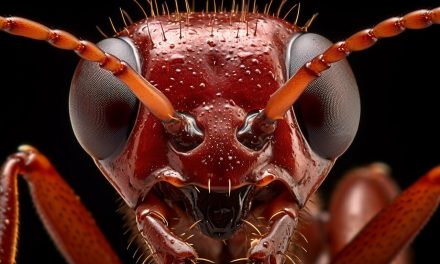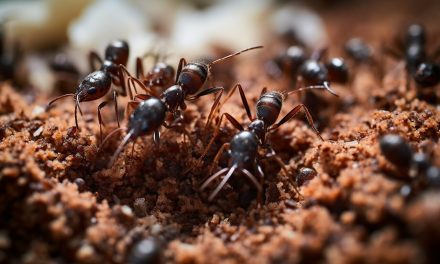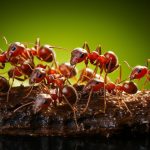This post may contain affiliate links.
Ants have a unique way of seeing the world around them through their compound eyes. These compound eyes are made up of many units called ommatidia, with each ommatidium responsible for seeing one point in space. This results in ants having a blurry overall vision of their surroundings. The size of an ant’s body directly affects the size of its eyes and the number of ommatidia, leading to even blurrier vision for smaller ants.
Despite their blurry vision, ants are remarkably skilled at carrying out tasks such as navigation. They utilize their visual system to detect and detour around obstacles, with smaller ants needing to be closer to an obstacle to find an alternative route compared to larger ants. Ants also communicate with each other through chemical trails laid by their social stomachs. They sense and follow these trails using their antennae, which play a crucial role in their sensory functions.
Ants’ antennae are multifunctional, serving purposes beyond just communication. They use their antennae for smelling, tasting, touching, and communicating with other ants. Although ants do not have ears, they are still able to sense sound vibrations through various organs on their legs, antennae, thorax, and head.
One interesting aspect of ant vision is their near-sightedness. Ants primarily see objects that are close to them, and their vision becomes less clear as the distance increases.
Key Takeaways:
- Ants have compound eyes made up of ommatidia, resulting in a blurry overall vision.
- The size of an ant’s body affects the size of its eyes and the number of ommatidia, leading to even blurrier vision for smaller ants.
- Despite their blurry vision, ants are skilled at tasks such as navigation.
- Ants communicate with each other through chemical trails and sense these trails using their antennae.
- Ants’ antennae serve functions such as smelling, tasting, touching, and communication.
- Ants can sense sound vibrations despite not having ears.
- Ants have near-sighted vision, primarily seeing objects that are close to them.
The Structure of Ant Eyes
Ants have compound eyes composed of numerous individual units called ommatidia. These ommatidia work together to form a mosaic-like structure, providing ants with a wide field of vision and allowing them to detect movement and changes in light intensity. Each ommatidium functions as a tiny eye, with its own lens, photoreceptor cells, and nerve fibers.
The collective input from these ommatidia allows ants to perceive their environment. Although each ommatidium sees only one point in space, the overlapping visual fields of multiple ommatidia create an overall picture. However, this mosaic-like structure gives ants a somewhat blurry vision, as the individual images captured by each ommatidium are not as sharp as those produced by a single-lens eye. Nonetheless, ants have adapted to make the most of their visual capabilities.
Miniaturization plays a significant role in how ants perceive their surroundings. Smaller ants have smaller eyes and fewer ommatidia compared to their larger counterparts. As a result, their vision is even blurrier, making it more challenging for them to distinguish fine details. This miniature size also affects their ability to detect and detour around obstacles. Smaller ants need to be closer to an obstacle to detour, while larger ants can spot and navigate around obstacles from a greater distance.
The Structure of Ant Eyes
| Ommatidia | Field of Vision | Visual Acuity |
|---|---|---|
| Small Ants | Less Overlapping | Blurrier |
| Large Ants | More Overlapping | Sharper |
- Ants have compound eyes composed of multiple ommatidia.
- The mosaic-like structure of ant eyes provides a wide field of vision.
- Each ommatidium sees one point in space, resulting in a blurry overall vision.
- Smaller ants have smaller eyes with fewer ommatidia, leading to even blurrier vision.
- Miniaturization affects their ability to detect and detour around obstacles.
- Larger ants can navigate and spot obstacles from a greater distance compared to smaller ants.
“The compound eyes of ants are marvels of nature, with their intricate structures and collective visual input. While ants may not have the sharpest vision, they have developed remarkable adaptations to overcome the limitations of their blurry eyesight.”
– Dr. Entomologist
Despite their blurry vision, ants are still able to navigate and carry out their tasks with remarkable precision. This is due to their ability to compensate for their visual limitations by relying on other senses and cues, such as chemical trails and antennal communication. By using chemical trails laid by their social stomachs, ants can communicate with one another and navigate their environment. They perceive these trails through sensory receptors located on their antennae.
The antennae of ants play a crucial role in their sensory perception. Ants use their antennae not only for receiving chemical signals but also for detecting smells, tasting substances, and touching objects. These versatile appendages serve as a multi-purpose tool, allowing ants to interact with their environment and communicate with other members of their colony.
| Sensory Functions of Ant Antennae |
|---|
| Smelling |
| Tasting |
| Touching |
| Communication |
Incredibly, ants do not possess ears like humans do, yet they can still sense sound vibrations. Specialized organs located on their legs, antennae, thorax, and head allow them to detect auditory signals. These organs enable ants to communicate acoustically and respond to specific vibrational patterns in their environment. While their auditory capabilities may be different from our own, they nevertheless demonstrate the incredible adaptability and resourcefulness of these remarkable creatures.
Ultimately, ants have near-sighted vision, primarily perceiving objects that are close to them. They rely on their compound eyes, chemical trails, antennae, and other sensory mechanisms to navigate their world and communicate with their fellow ants. Despite their blurry vision, ants have developed sophisticated strategies and adaptations that enable them to thrive in their social communities and accomplish incredible feats.
Ants’ Blurry Vision
Ants’ blurry vision is a result of each ommatidium seeing only one point in space. These small units that make up the compound eyes of ants capture light and create a mosaic-like image. While this allows ants to detect movement and perceive their surroundings, it results in a lack of clarity and detail in their visual perception. Imagine seeing the world through multiple pinhole cameras, where each camera captures a different portion of the scene.
Due to the nature of their compound eyes, ants’ vision is especially blurry when compared to the sharp and detailed vision of humans. The number of ommatidia present in an ant’s eyes depends on its species and size, with larger ants typically having more ommatidia. This means that smaller ants have smaller eyes and fewer ommatidia, leading to even blurrier vision.
However, despite their blurry vision, ants are remarkable navigators. They are able to carry out complex tasks and find their way back to their nests with remarkable precision. This is made possible through their ability to perceive and interpret other sensory cues in their environment, such as chemical trails and sound vibrations.
To summarize, ants’ blurry vision is a result of their compound eyes and the limited visual information that each ommatidium provides. Despite this limitation, ants have evolved to rely on other sensory cues and mechanisms to navigate and communicate effectively in their environment.
Size and Vision
The size of ants and their eyes directly affects their visual capabilities. Ants have compound eyes made up of many units called ommatidia. Each ommatidium sees one point in space, resulting in a blurry overall vision. As ants get smaller, their bodies and eyes also become smaller, which means they have fewer ommatidia and even blurrier vision. This miniaturization has an impact on their ability to detect and detour around obstacles.
Smaller ants need to be closer to an obstacle in order to detour compared to larger ants. This is because their smaller eyes and fewer ommatidia limit their ability to perceive distant objects clearly. However, despite their blurry vision, ants are still able to carry out complex tasks like navigation with remarkable precision.
“Ants may have blurry vision, but they are masters of precision when it comes to finding their way.”
Table 1: Ant Size and Visual Capabilities
| Ant Size | Eye Size | Number of Ommatidia | Visual Acuity |
|---|---|---|---|
| Large Ants | Relatively larger | More ommatidia | Clearer |
| Small Ants | Relatively smaller | Fewer ommatidia | Blurrier |
In summary, ants’ size and eye structure directly affect their visual capabilities. Smaller ants have smaller eyes with fewer ommatidia, resulting in blurry vision. Despite this, ants have developed remarkable abilities to navigate and perform complex tasks. They rely on chemical trails laid by their social stomachs and sense these trails through their antennae. Ants also use their antennae for smelling, tasting, touching, and communicating with other ants. Although they do not have ears, ants can sense sound vibrations using organs on their legs, antennae, thorax, and head. Additionally, ants have near-sighted vision, primarily perceiving objects that are close to them.
Ants’ Navigation Abilities
Surprisingly, ants are able to navigate and complete complex tasks despite their limited visual acuity. Their compound eyes, made up of numerous units called ommatidia, provide them with a blurry overall vision. Each ommatidium sees one point in space, resulting in a fragmented view of the world. The smaller the ant, the smaller its eyes and the fewer ommatidia it possesses, leading to even blurrier vision. However, these remarkable creatures have developed ingenious strategies to overcome these challenges and navigate their environment with astonishing precision.
One key aspect of ant navigation is their ability to detect and detour around obstacles. Miniaturization affects their ability to perceive and react to objects in their path. Smaller ants need to be closer to an obstacle in order to detour around it compared to larger ants. They rely on their acute sensing skills and tactile communication to navigate intricate terrain and accomplish their missions.
Another fascinating aspect of ant navigation is their remarkable communication system. Ants use chemical trails laid by their social stomachs to communicate with each other. They also possess specialized sensory organs located on their antennae that allow them to sense these trails. These chemical trails act as a form of communication, providing information about food sources, marking territories, and even alerting others of potential threats.
Ants’ antennae play a crucial role in their sensory perception. Apart from sensing chemical trails, these versatile appendages are used for smelling, tasting, touching, and communicating with other members of their colony. They have an impressive range of sensory functions that enable them to navigate complex environments and interact with their surroundings.
| Ant Sensory Functions | How they Use It |
|---|---|
| Smelling | Identifying food sources and recognizing nestmates |
| Tasting | Determining the quality of food and identifying colony members |
| Touching | Exploring the environment and communicating with other ants |
Intriguingly, while ants lack ears, they can still sense sound vibrations. They have specialized organs located on their legs, antennae, thorax, and head that allow them to detect auditory signals. This ability to perceive sound vibrations plays a crucial role in their communication and helps them stay attuned to their surroundings.
Ants possess near-sighted vision, meaning they primarily see objects that are close to them. This visual acuity allows them to focus on their immediate environment and carry out intricate tasks with precision. Although their overall vision may be blurry, ants rely on their other senses and their remarkable navigational skills to overcome these limitations and thrive in their complex social communities.
Communication Through Chemical Trails
Ants have a sophisticated communication system based on chemical trails that they lay and perceive through their antennae. These chemical trails, also known as pheromones, play a crucial role in guiding ants towards food sources, alerting others to danger, and even identifying members of the same species. They are like a secret language that only ants can understand.
When an ant finds a source of food, it leaves a trail of pheromones as it returns to the nest, marking the path for other ants to follow. As more ants travel along the trail, they reinforce the pheromone scent, making it stronger and easier to detect. This efficient communication method allows the entire colony to efficiently gather food and navigate their surroundings.
The chemical trails not only lead ants to food but also serve as a means of communication between individual ants. Ants can use different combinations of pheromones to convey specific messages to their fellow ants. For example, they may use one combination to indicate the presence of food, another to warn of danger, and yet another to identify themselves as members of the same colony. These chemical “words” create a complex language that ants utilize to coordinate their activities and maintain the social structure of the colony.
| Chemical Pheromones | Meaning |
|---|---|
| Trail Pheromones | Guide ants to food sources |
| Alarm Pheromones | Warn of danger |
| Recognition Pheromones | Identify members of the same species or colony |
Ants’ antennae play a crucial role in perceiving and interpreting these chemical trails. These specialized appendages have sensory receptors that allow ants to detect and recognize the pheromone signals, enabling them to respond accordingly. Ants use their antennae not just for chemical communication but also for other sensory functions like smelling, tasting, and touching. They are true multitaskers!
In conclusion, ants have developed a remarkable system of communication through chemical trails, which they lay and perceive through their antennae. This system allows them to coordinate their activities, navigate their environment, and maintain the social structure of their colonies. Chemical trails are the secret language that binds ant communities together, ensuring their survival and success.
The Role of Antennae
Antennae play a crucial role in an ant’s ability to perceive and interact with its environment. These amazing sensory organs, located on their heads, allow ants to navigate their surroundings, communicate with other ants, and gather important information about food sources and potential threats. Through a combination of touch, smell, and taste, an ant’s antennae provide a wealth of sensory input that is essential for its survival.
One of the key functions of an ant’s antennae is their olfactory abilities. Ants use their antennae to detect chemical signals in the form of pheromones, which are released by other ants to communicate various messages. These chemical trails act as a form of communication, guiding ants towards food sources, alerting them to danger, and even helping them recognize members of their own colony. It’s fascinating to think that ants have developed their own chemical language, using their antennae to “read” and interpret these signals.
In addition to their olfactory role, an ant’s antennae also serve as sensory receptors for touch and taste. By brushing their antennae against objects in their environment, ants can gather critical information about their surroundings. They can sense the texture and hardness of surfaces, detect vibrations caused by movement, and even taste substances to determine if they are edible. It’s truly remarkable how these seemingly simple appendages can provide ants with such a wealth of sensory data, allowing them to navigate their complex world with precision.
The Sensory Powers of Antennae
Antennae are not just passive receivers of sensory information; they also play an active role in communication among ants. Through subtle movements and touches with their antennae, ants can convey messages to each other, signaling their intentions or responding to social cues. It’s as if their antennae act as a sort of antennal semaphore, allowing ants to communicate and coordinate their activities without the need for vocalizations.
To fully appreciate the remarkable sensory powers of ants’ antennae, we can refer to a table that summarizes their functions:
| Sensory Function | Antennal Role |
|---|---|
| Smelling | Antennae detect chemical signals, like pheromones, in the air |
| Tasting | Antennae come into contact with substances, allowing ants to assess their edibility |
| Touching | Antennae brush against objects to gather information about their physical properties |
| Communicating | Antennae allow ants to convey messages and coordinate their activities |
When we consider the vital role that antennae play in an ant’s sensory experience, it becomes clear that these humble appendages are truly extraordinary. They enable ants to navigate their world, communicate with their peers, and make sense of the complex chemical signals that surround them. Next time you observe ants going about their daily routines, take a moment to marvel at the incredible capabilities of their antennae and the vital role they play in their lives.
Sensing Sound Vibrations
Although ants don’t have ears, they can still sense sound vibrations through specialized organs on their legs, antennae, thorax, and head. These unique sensory adaptations allow ants to pick up on auditory signals and communicate effectively within their colonies.
The organs used by ants to detect sound vibrations vary depending on the species and context. For example, some ants use tiny sensory hairs on their legs to perceive vibrations in the ground, enabling them to detect the movement of nearby predators or approaching colony members. This helps them stay alert and respond quickly to potential danger.
Antennae, which are primarily used for smelling, also play a role in sound perception. The antennae of certain ant species have been found to vibrate in response to sound waves, converting acoustic signals into sensory information that ants can interpret. This unique ability allows them to pick up on subtle auditory cues and communicate with other ants in their colony.
Additionally, ants utilize specialized organs on their thorax and head to sense sound vibrations. These organs, known as Johnston’s organs, are equipped with sensory cells that are sensitive to specific frequencies. By detecting and interpreting these vibrations, ants can navigate their environment, locate food sources, and communicate effectively with other members of their colony.
| Organs | Function |
|---|---|
| Legs | Sense vibrations in the ground |
| Antennae | Vibrate in response to sound waves |
| Thorax and head | Harbor Johnston’s organs for detecting sound vibrations |
“Although ants don’t have ears, their ability to sense sound vibrations through various specialized organs is truly remarkable.”
In conclusion, ants have developed extraordinary adaptations to sense sound vibrations despite the absence of ears. These unique sensory organs, located on their legs, antennae, thorax, and head, allow ants to communicate, navigate their environment, and respond to potential threats. This remarkable ability further highlights the fascinating complexity of ants’ sensory systems and their remarkable survival strategies within the natural world.
Near-Sighted Vision
Ants have near-sighted vision, allowing them to primarily perceive objects that are in close proximity. Due to their compound eyes and the structure of their ommatidia, ants have a blurry overall vision. Each ommatidium sees one point in space, resulting in a mosaic-like image. This visual limitation is more pronounced in smaller ants, as they have smaller eyes with fewer ommatidia, leading to even blurrier vision.
Despite this visual impairment, ants are still able to navigate and carry out tasks with remarkable precision. Miniaturization affects their ability to detect and detour around obstacles, with smaller ants needing to be closer to an obstacle to detour compared to larger ants. Their exceptional navigational skills are attributed to other cues, such as chemical trails and sensory information gathered through their antennae.
Ants communicate through chemical trails laid by their social stomachs and sense these trails through their antennae. They have approximately 10 to 20 chemical “words” that allow them to identify ants of the same species, show others where food is, and raise an alarm. Their antennae play a crucial role in not only chemical communication but also in other sensory functions. Ants use their antennae to smell, taste, touch, and communicate with other ants, making them essential sensory organs.
Interestingly, ants do not have ears, but they can sense sound vibrations through specialized organs located on their legs, antennae, thorax, and head. These organs enable ants to detect auditory signals and respond accordingly. However, their primary mode of perception remains their near-sighted vision, which allows them to focus on objects that are close to them.
| Ant Vision Overview |
|---|
| Near-sighted vision |
| Compound eyes with ommatidia |
| Blurry overall vision |
| Visual impairment more pronounced in smaller ants |
| Navigation skills rely on other cues |
| Chemical trails and antennae play vital roles in communication |
| Ants can sense sound vibrations through specialized organs |
Summary and Conclusion
The visual system of ants is a fascinating adaptation that allows them to navigate and communicate effectively in their unique world. With compound eyes composed of multiple ommatidia, ants possess a blurry overall vision. Each ommatidium sees one point in space, resulting in a fragmented perception of their surroundings. This visual limitation is further pronounced in smaller ants, as they have fewer ommatidia and smaller eyes, leading to even blurrier vision.
Despite their blurry vision, ants are remarkably skilled at carrying out tasks and navigating their environment. Their ability to detect and detour around obstacles is impacted by their size, with smaller ants needing to be closer to an obstacle to detour compared to their larger counterparts. Nevertheless, ants demonstrate remarkable precision in their movements.
Communication plays a crucial role in ant societies, and chemical trails are their primary means of conveying information. Ants communicate with each other through chemical trails laid by their social stomachs. These trails contain 10-20 chemical “words” that allow ants to identify members of the same species, locate food sources, and raise alarms when necessary. Through their antennae, ants can sense and interpret these chemical signals, enabling effective communication within their colonies.
Ants rely on their antennae not only for chemical communication but also for multiple sensory functions. These delicate appendages are used for smelling, tasting, touching, and even communicating with other ants. They are crucial in navigating the world around them and acquiring essential information about their environment.
While ants lack ears, they are capable of sensing sound vibrations through specialized organs located on their legs, antennae, thorax, and head. This unique adaptation allows ants to respond to auditory cues in their environment, enhancing their ability to communicate and react to potential threats.
In terms of their visual capabilities, ants have near-sighted vision, primarily perceiving objects that are in close proximity to them. This visual limitation, combined with their reliance on chemical trails and antennae, contributes to their highly efficient and cooperative behavior within their colonies.
In conclusion, the visual system of ants is a remarkable adaptation that enables them to navigate and communicate effectively in their complex social structures. Despite their blurry vision, ants have developed various compensatory mechanisms, such as chemical communication and sensory antennae, to thrive in their unique world.
Do Ants Have Immune Systems That Prevent Them from Getting Sick?
Ants, fascinating creatures of the insect world, indeed possess immune systems that shield them from sickness. Surprisingly, why ants are immune to sickness lies in their remarkable social structure. Their colonies exhibit a division of labor, enabling some ants to specialize in fighting off infections. Through a combination of physical barriers, antimicrobial secretions, and immune responses, ants have evolved an efficient defense mechanism against various pathogens. Their impressive immune systems contribute to their resilience and unwavering survival.
Do Ants Have a Short Lifespan?
Ant daily mortality explained: Despite their small size, ants actually have a relatively short lifespan. Worker ants typically live for a few months, while the queen ant can survive for several years. This short lifespan is partly due to the harsh conditions they face and the demanding tasks they perform daily, such as foraging, nursing, and defending the colony. Thus, ant daily mortality is an essential aspect of their ecosystem.
FAQ
Q: How do ants see?
A: Ants have compound eyes composed of many units called ommatidia. Each ommatidium sees one point in space, resulting in a blurry overall vision.
Q: What is the structure of ant eyes?
A: Ant eyes are made up of many units called ommatidia, which form their compound eyes.
Q: Why do ants have blurry vision?
A: Due to their compound eyes, ants have blurry vision as each ommatidium sees one point in space, resulting in an overall blurry perception.
Q: How does the size of ants affect their vision?
A: Smaller ants have smaller eyes and fewer ommatidia, leading to even blurrier vision compared to larger ants.
Q: How do ants navigate despite their blurry vision?
A: Despite their blurry vision, ants are still able to carry out tasks and navigate with remarkable precision.
Q: How do ants communicate with each other?
A: Ants communicate through chemical trails laid by their social stomachs and sense these trails through their antennae.
Q: What is the role of ants’ antennae?
A: Ants use their antennae for smelling, tasting, touching, and communicating with other ants.
Q: How do ants sense sound vibrations without ears?
A: Ants can sense sound vibrations through organs on their legs, antennae, thorax, and head, despite not having ears.
Q: Do ants have near-sighted vision?
A: Yes, ants have near-sighted vision and primarily see objects that are close to them.










